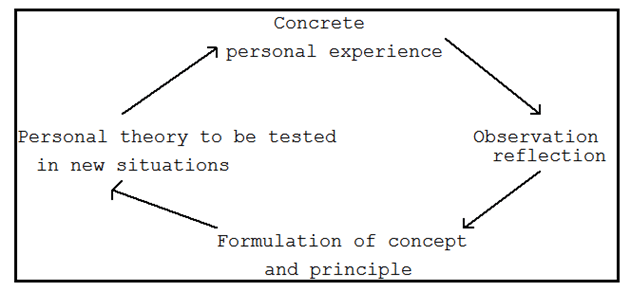Critical Safety Reflection or thinking about stuff
By the late George Robotham
This brief article was prompted by an excellent paper in the Central Alberta Well Services Corporation, Safety Newsletter, Vol2, Issue 6 by Mark Sanborn, www.marksanborn.com titled “Think like a leader and lead like a thinker”
Action Learning
There is a large body of research literature that suggests that action learning is particularly appropriate for adults.
Learning may be defined (Mezirow 1991,1) as the process of making a new or revised interpretation of the meaning of an experience which guides subsequent understanding, appreciation and action. Critical reflection involves a critique of the pre-suppositions on which our beliefs have been built.
The video “An Introduction to Action Learning” The National Staff Development Committee (1995) outlines the benefits and process of action learning.
The following equation is referred to:
L = P + Q where L = Learning
P = Programmed knowledge balanced with
Q = Questioning insight
Experiential Learning
This has some similarities to action learning and once again is thought to be particularly relevant to adult learners.
Kolb and Fry (1975, 33) have developed an experiential learning model.

Figure 1 : Experiential Learning Model, Kolb and Fry (1975, 33)
The process of experiential learning is shown below. (Johnson 1990, 20) The learner reflects on their concrete experiences and examines their meaning in order to formulate a set of concepts or principles. The sequence is concrete personal experiences followed by:-
Observation and reflection and examination of one’s experiences and this leads to the formulation of abstract concepts and generalisations which leads to hypotheses to be tested in future action.

Figure 2 : Experiential Learning Cycle (Johnson 1990, 20)
You will note the role of critical reflection or thinking about stuff in both action learning and experiential learning.
There are many ways critical reflection or thinking about stuff can be used to enhance learning-
1 Reading-Reading new material helps you learn, it helps to hit key points with a highlighter pen or make your own notes of key points as you read.
2 Facilitation-Being an enlightened facilitator of adult learning I build activities for my learners into the process. Often I ask the learners to reflect on the activity and discuss what went well and what opportunities for improvement were presented, frequently this is where the real learning occurs.
3 Reflective journal-When I did my Bachelor of Education (Adult & Workplace Education) we had to do a reflective journal of our placements in industry doing practical training work. The requirement was to describe what we did and comment on what went well and what opportunities for improvement were presented (ie the stuff ups) and comment how we would do better next time. It was said reflective journals were an excellent way for adults to learn.
When I completed my assessment to become a Chartered Fellow of the Safety Institute of Australia part of the process was to write a reflective journal of my work experience for 3 months.
I do some work for an organisation that conducts adventure-based lifestyle training for “at risk” youth. The young people have to do a reflective journal on their experiences, amazing what insights are often found in some troubled minds.
I have been maintaining a personal reflective journal for the last 10 years, started out trying to remember the first 40 years of my life and jotted it down, every now and again I recall something extra about this and bung it in. From then on I have just commented on the things that have happened and reflect and comment on them.
For me reflective journals have helped with my learning.
4 Reflective listening-On a counselling subject I was introduced to and practised reflective listening. This is a very powerful technique to get to the core beliefs of those around you. Someone says something, you may say “If I understand you properly you think x” ,this gives the other party the opportunity to think about and expand on their view or “Correct me if I am wrong but I think you are saying y” I suggest everybody reads up on this technique, it can make your life much easier.
5 Time to think-It helps if you regularly set aside some quiet time to think. A beer, wine, tea or coffee is appropriate, you might like to reflect on your day or week and jot down a few notes. Have an appropriate quiet place to think.
6 Writing stuff down-Writing stuff down, whether on the computer or hard copy helps you to clarify your thoughts. Often going back to it after a few days will give you new insights.
7 Give and ask for feedback- There will be times you do not like or agree with what people say they think about you or what you have done, regardless of this it pays to think about what is said and possibly make required adjustments.
8 When communicating with others try to put yourself in the other persons shoes. Try to think about “What’s in it for me” from their perspective.
9 When writing something important write a draft and go back to it the next day, or a couple of days later if you have that luxury. It is amazing how thinking about things for awhile can give improvements.
References
Johnson, D. W. 1990, Reaching Out, Prentice Hall, New Jersey.
Kolb, D. and Fry, R 1975, Towards an Applied Theory of Experimental Learning
Mezirow, J. 1981, “A Critical Theory of Adult Learning and Education”, Adult Education, 32(1) , 3-24.
The National Staff Development Committee, 1995, An Introduction to Action Learning, Melbourne.



Do you have any thoughts? Please share them below